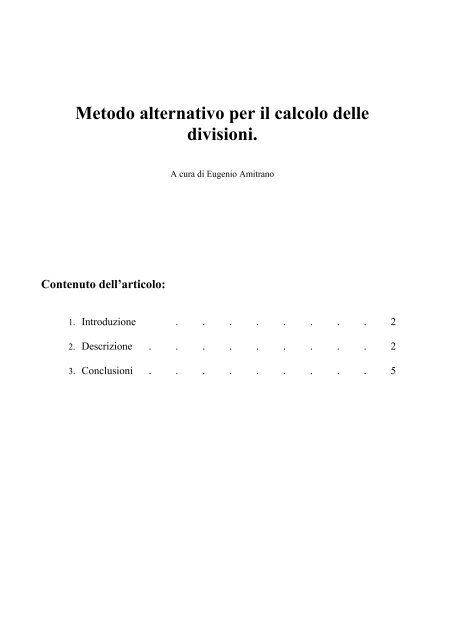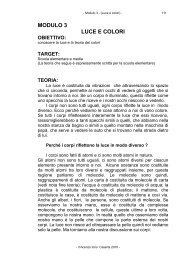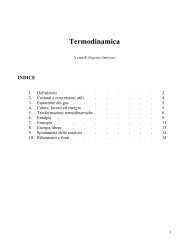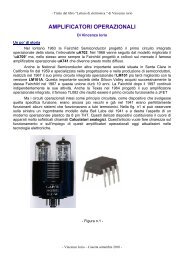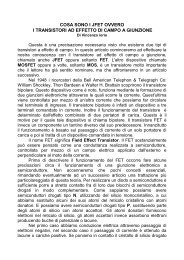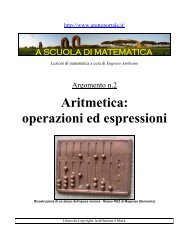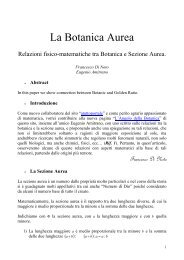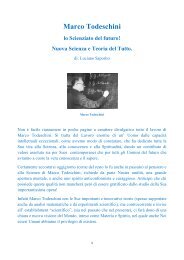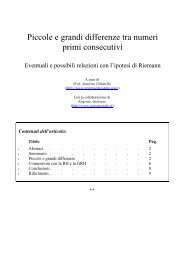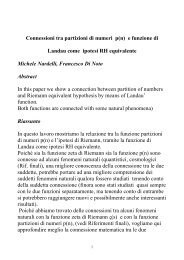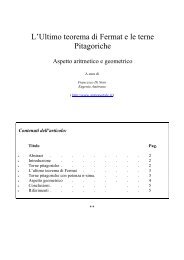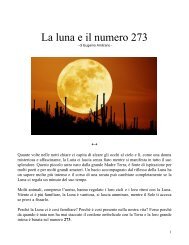Metodo alternativo per il calcolo delle divisioni - atuttoportale
Metodo alternativo per il calcolo delle divisioni - atuttoportale
Metodo alternativo per il calcolo delle divisioni - atuttoportale
You also want an ePaper? Increase the reach of your titles
YUMPU automatically turns print PDFs into web optimized ePapers that Google loves.
<strong>Metodo</strong> <strong>alternativo</strong> <strong>per</strong> <strong>il</strong> <strong>calcolo</strong> <strong>delle</strong><br />
<strong>divisioni</strong>.<br />
A cura di Eugenio Amitrano<br />
Contenuto dell’articolo:<br />
1. Introduzione . . . . . . . . 2<br />
2. Descrizione . . . . . . . . . 2<br />
3. Conclusioni . . . . . . . . . 5
<strong>Metodo</strong> <strong>alternativo</strong> <strong>per</strong> <strong>il</strong> <strong>calcolo</strong> <strong>delle</strong> <strong>divisioni</strong>.<br />
1. Introduzione<br />
Il presente articolo vuole fornire un metodo <strong>alternativo</strong> <strong>per</strong> <strong>il</strong> <strong>calcolo</strong> di una qualsiasi<br />
divisione. Tale metodo comporta una certa convenienza nel <strong>calcolo</strong> mentale se gli<br />
elementi della divisione, dividendo e divisore, possiedono le seguenti proprietà:<br />
Dividendo molto piccolo o fac<strong>il</strong>mente moltiplicab<strong>il</strong>e a mente;<br />
Divisore prossimo alle potenze di dieci (10 n ).<br />
Ad esempio, è possib<strong>il</strong>e calcolare a mente una divisione come 4 ÷ 998 in pochissimi<br />
secondi e con una precisione che farebbe invidia a numerosissime calcolatrici in<br />
commercio.<br />
2. Descrizione<br />
Data una divisione X ÷ Y , identifichiamo i tre elementi principali che serviranno alla<br />
costruzione del risultato:<br />
1) Una BASE indicata con B, che corrisponde al dividendo ( B = X );<br />
2) Un PASSO indicato con P, che corrisponde al numero <strong>delle</strong> cifre del divisore.<br />
( P = len(Y ) )<br />
3) Un MOTIPLICATORE indicato con M, che corrisponde alla P-esima<br />
potenza di dieci sottratta del divisore. ( M = 10 P − Y )<br />
Una volta trovati questi tre elementi, <strong>il</strong> risultato della divisione è dettato dalla<br />
seguente formula:<br />
X<br />
÷<br />
Y<br />
=<br />
GP<br />
∑<br />
n=<br />
1<br />
B ⋅ M<br />
10<br />
( n−<br />
1)<br />
nP<br />
Il valore GP rappresenta <strong>il</strong> grado di precisione che si vuole ut<strong>il</strong>izzare.<br />
In realtà, quando X > Y , potrebbe risultare diffic<strong>il</strong>e applicare la formula. A tale<br />
scopo, è possib<strong>il</strong>e trasformare <strong>il</strong> dividendo nella forma X = kY + Z , dove k è un<br />
numero intero. Così facendo risulta X ÷ Y = ( kY + Z ) ÷ Y , applicando la proprietà della<br />
scomposizione ( kY + Z ) ÷ Y = kY ÷ Y + Z ÷ Y = k + Z ÷ Y . Quindi X ÷ Y = k + Z ÷ Y , dove<br />
Z < Y e sotto questa forma <strong>il</strong> <strong>calcolo</strong> risulta molto più semplice. Infatti, <strong>il</strong> metodo è<br />
molto pratico <strong>per</strong> determinare la parte decimale.<br />
Eugenio Amitrano 2
<strong>Metodo</strong> <strong>alternativo</strong> <strong>per</strong> <strong>il</strong> <strong>calcolo</strong> <strong>delle</strong> <strong>divisioni</strong>.<br />
Per comprendere meglio i benefici di questo metodo <strong>alternativo</strong> è opportuno qualche<br />
esempio avente le proprietà citate nell’introduzione.<br />
• Esempio 1:<br />
Divisione 4 ÷ 998<br />
Grado di precisione GP = 7<br />
Ricaviamo i tre elementi principali.<br />
<strong>il</strong> dividendo è 4 , quindi la base B = 4 ; <strong>il</strong> divisore 998 è composto da tre cifre, quindi<br />
P<br />
3<br />
<strong>il</strong> passo P = 3 ; infine, l’espressione 10 − Y = 10 − 998 = 1000 − 998 = 2 , quindi <strong>il</strong><br />
moltiplicatore M = 2 .<br />
B = 4 P = 3 M = 2<br />
Essendo X <<br />
del tipo 0,...<br />
Y , <strong>il</strong> risultato della divisione è un numero minore di 1, ossia un numero<br />
La parte decimale è costituita da una successione ( Cn ) = { C0<br />
, C1,<br />
C2,<br />
...}<br />
∀ n∈<br />
N0<br />
di<br />
numeri a P cifre, che in questo caso le cifre sono 3.<br />
Il primo elemento è uguale alla base C<br />
0<br />
= B = 4 , mentre i termini successivi sono dati<br />
dalla relazione C<br />
n<br />
= M ⋅ Cn−<br />
1 .<br />
C 004 C 008 C 016 C 032 C 064 C 128 C = 256<br />
6<br />
0 =<br />
1 =<br />
A questo punto, possiamo scrivere <strong>il</strong> risultato:<br />
• Esempio 2:<br />
Divisione 5 ÷ 997<br />
Grado di precisione GP = 6<br />
2 =<br />
3 =<br />
4 =<br />
B = 5 P = 3 M = 3<br />
C 005 C 015 C 045 C 135 C 405 C = 1215<br />
5<br />
0 =<br />
1 =<br />
4 ÷ 998 =<br />
2 =<br />
0,004008015032064128256<br />
3 =<br />
4 =<br />
5 =<br />
Eugenio Amitrano 3
<strong>Metodo</strong> <strong>alternativo</strong> <strong>per</strong> <strong>il</strong> <strong>calcolo</strong> <strong>delle</strong> <strong>divisioni</strong>.<br />
Attenzione! I termini della successione devono essere di 3 cifre, in quanto P = 3 ,<br />
mentre C = 5<br />
1215, risulta essere di 4 cifre. A questo punto, <strong>il</strong> termine C<br />
5 si tronca a 3<br />
cifre, e la cifra troncata si riporta al termine precedente: C = 5<br />
215 e C4 = 405 + 1 = 406<br />
I termini della successione sono quindi tutti a tre cifre:<br />
C 005 C 015 C 045 C 135 C 406 C = 215<br />
5<br />
0 =<br />
1 =<br />
2 =<br />
Ora non ci resta che scrivere <strong>il</strong> risultato.<br />
5 ÷ 997 =<br />
3 =<br />
0,005015045135406215<br />
NOTA:<br />
La diciottesima cifra decimale (l’ultima) corretta è 8 e non 5, <strong>il</strong> motivo sta nel fatto<br />
che <strong>il</strong> termine successivo della successione C = 6<br />
3645, <strong>per</strong> cui al termine C<br />
5 va<br />
sommato <strong>il</strong> 3. C = 5<br />
218<br />
C 005 C 015 C 045 C 135 C 406 C = 218<br />
5<br />
0 =<br />
1 =<br />
2 =<br />
E <strong>il</strong> risultato corretto è 0 ,005015045135406218, approssimato <strong>per</strong> difetto e<br />
0 ,005015045135406219 approssimato <strong>per</strong> eccesso.<br />
• Esempio 3:<br />
3 =<br />
4 =<br />
4 =<br />
Ora, un esempio con<br />
X > Y .<br />
Divisione 199 ÷ 98<br />
Grado di precisione GP = 5<br />
Il dividendo 199 corrisponde a 2 ⋅ 98 + 3, quindi possiamo scrivere la divisione nel<br />
seguente modo:<br />
199 ÷ 98 = ( 2 ⋅ 98 + 3) ÷ 98 = 2 ⋅ 98 ÷ 98 + 3 ÷ 98 = 2 + 3 ÷ 98<br />
La divisione da calcolare è 3 ÷ 98, e <strong>il</strong> risultato è un numero del tipo 2,...<br />
B = 3 P = 2 M = 2<br />
C 03 C 06 C 12 C 24 C = 48 4<br />
0 =<br />
Il risultato di 98<br />
1 =<br />
199 ÷ è 2 , 0306122448 .<br />
2 =<br />
3 =<br />
Eugenio Amitrano 4
<strong>Metodo</strong> <strong>alternativo</strong> <strong>per</strong> <strong>il</strong> <strong>calcolo</strong> <strong>delle</strong> <strong>divisioni</strong>.<br />
3. Conclusioni<br />
Oltre al <strong>calcolo</strong> mentale rapido nei casi sopra citati, questo metodo può essere<br />
impiegato nel campo informatico <strong>per</strong> ottenere un numero elevatissimo di cifre<br />
decimali.<br />
Eugenio Amitrano 5


